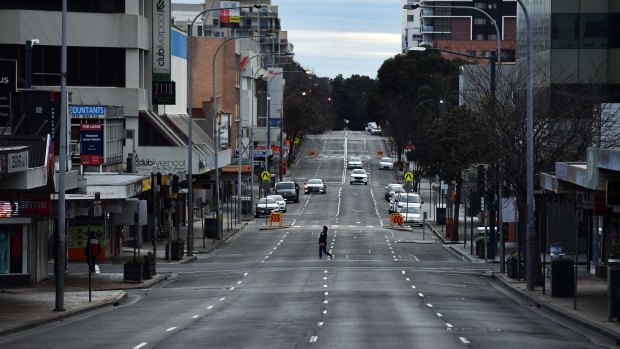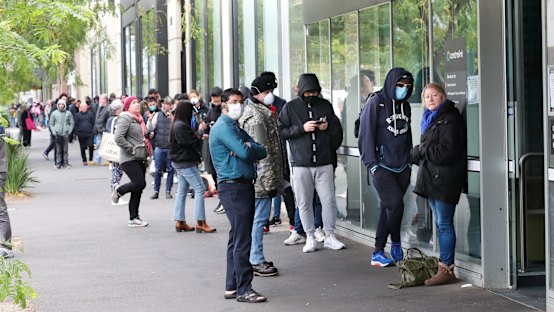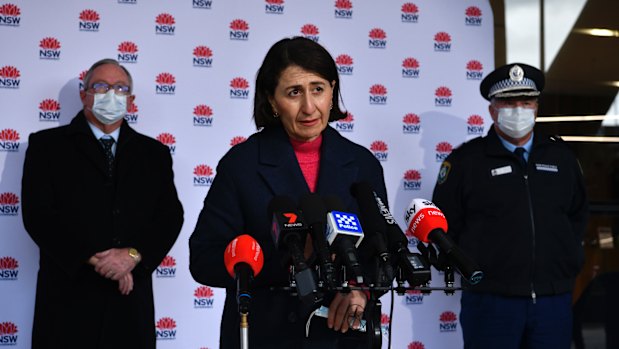This was published 3 years ago
Opinion
Sydney needs another JobKeeper to survive this lockdown
Emma Dawson
ContributorOne hundred and twelve days. That was the total length of Melbourne’s winter lockdown last year. Sixteen weeks with businesses shuttered, children kept home from school, no visits with family or friends. What began a year ago last week as targeted, postcode-based restrictions after COVID-19 escaped hotel quarantine became, within a month, a state of disaster that shut down all but the most essential services across the state.
So, as Greater Sydney enters a third week of lockdown, the view of the city from Melbourne is grimly familiar, although there are some significant differences. Most worryingly, the Delta variant is much more contagious. On the upside, vaccines are (too slowly) being delivered, providing a light at the end of the tunnel that wasn’t visible in the dark Melbourne winter of 2020.

Shoppers walk on George Street in Liverpool on Saturday.Credit: SAM MOOY
Perhaps the most material difference, though, is the lack of economic support from the federal government for Sydney businesses and their employees. Victoria’s lockdown was brutal, and its impact disproportionately felt by casual workers and those in unsupported sectors such as universities and the arts, but most workers and businesses received extraordinary levels of income support through the JobKeeper scheme.
With $1500 a fortnight for every eligible worker, paid through their employer, the scheme wasdesigned to keep people attached to their jobs during a period of unprecedented uncertainty.
Critically, JobKeeper involved no complex application process or eligibility requirements. The money was simply deposited into people’s accounts every fortnight, replacing all or part of - and in some cases even exceeding - their regular salaries. The wage subsidy helped save many households from defaulting on their mortgage or their rent while also preventing the collapse of small and medium businesses across the state. At the peak of the lockdown last year, more than 3.8 million Australians – one in every three workers – was relying on JobKeeper payments.
A year on, JobKeeper is gone, and with it up to 100,000 jobs. When the payment was removed at the end of March, no one predicted another outbreak as big as the one with which NSW is now grappling, and an extended lockdown in Australia’s largest city was, we were told, unlikely under Sydney’s “gold standard” approach to the pandemic.

People queue at Centrelink in March last year, before JobKeeper was announced to keep employees linked to their employers.Credit: Jason South
In response to Sydney’s latest plight, the federal government has dropped the assets test for its new COVID-19 Disaster Payment of up to $500 a week: unlike those in Melbourne who applied for the payment during that city’s recent two-week lockdown, NSW residents will not have to run down their savings before becoming eligible for help.
But the support provided by this new scheme falls a long way short of that delivered through JobKeeper. Not only is the payment significantly less – for those who have lost up to 20 hours of work per week, the amount provided is just $325, the equivalent of 16 hours at the minimum wage – the structure that made JobKeeper so effective at providing people with security is entirely missing.
The Disaster Payment is provided directly to individual workers, rather than through employers. While this avoids the kind of rorting we saw from some employers, like Harvey Norman, which kept more than $22 million in JobKeeper payments across the chain while banking big profits, it breaks the essential link between workers and employers that was central to the JobKeeper scheme.
Smaller, customer-facing businesses such as hairdressers, cafes and independent retailers will struggle to get through an extended lockdown without a wage subsidy that allows them to retain staff and meet overheads while they cannot trade. The lack of a wage subsidy scheme must be a key factor in Premier Gladys Berejiklian’s decision not to order non-essential retailers to close their doors – a decision that may yet prove fatal, given the identification of more than 2,000 new close contacts in one day resulting from an infected person working at Ikea in Tempe last week.

NSW Premier Gladys Berejiklian breaks the news on Sunday that Sydney had recorded 77 new cases and one death.Credit: Dean Sewell
For workers, the process to receive the meagre disaster payment is unnecessarily complex, requiring a new application every seven days. This will only increase stress on already pressured families.
We all fervently hope the NSW lockdown doesn’t come close to the duration of Victoria’s ordeal last year. However with a further extension of stay-at-home orders almost assured after 77 new cases were recorded on Sunday and a woman in her nineties became the state’s first COVID-related death in 10 months, our most populous state faces weeks of uncertainty and the economic hit to households and businesses is likely to be severe.
Weekly disaster payments to individuals simply won’t provide the kind of security that employees and small and medium businesses need to get them through a lockdown that could extend for another month or more. A redesigned, targeted wage subsidy that keeps workers attached to their employers and guarantees a reliable fortnightly income until people can go back to work is now essential. It’s time for JobKeeper 2.0.
Emma Dawson is executive director of Per Capita.